| Origami Heaven A paperfolding
paradise
The website of
writer and paperfolding designer David Mitchell
x
|
| |
| Modular Designs based on the
3x3 and 5x5 grids |
| |
| The
oldest modular design known, the Tematebako, is based on
the 3x3 grid. When I began creating my own designs this
quickly became one of my favourite motifs. The 5x5 grid is much less
used. There must surely be other designs that I am not
aware of?
Where designs are
not otherwise attributed they are my own.
|
| |
| Designs
from the 3x3 grid |
| |
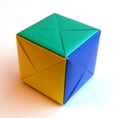 |
|
The Tematebako is
the earliest known modular origami design, dating
back to at least 1734. It is made from six
modules developed from the traditional Menko
using cuts. More information about the
Tematebako can be found here.
Online
diagrams can be found on the Designs of Unknown Origin page of this site.
|
|
| |
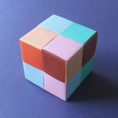 |
|
My Simplex
Cube is a robust cube assembled from 24
L-shaped Simplex modules. Cubes made from larger
numbers of modules are also possible. In fact
this is probably the best way to make complex
cubes from large numbers of modules. On-line diagrams are
available on the Modular Designs page of this site.
|
|
| |
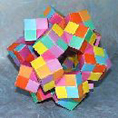 |
|
Simplex modules can
be used to make any shape that has square,
truncated square or silver triangle faces. This
is a Simplex module version of my Ball of
Cubes design. On-line diagrams are
available on the Modular Designs page of this site.
|
|
| |
 |
|
The Eureka
Cube is an even earlier 4-part design -
from 1988 - that depends on the division of a
square into thirds. It is so named because I
visualised the design whilst lazing in the bath.
Usually in these circumstances the design does
not work. This one did. On-line diagrams are
available on the Modular Designs page of this site.
|
|
| |
 |
|
The module for the basic 6-part Darwin
Cube, which I designed in 2001, is a
development of the Sonobe module. The basic
Darwin and Sonobe cubes look identical but this
is only because the four small flaps which allow
the Darwin module to be reconfigured to create
many interesting contrast patterns on the surface
of the cube are concealed from view in this
configuration. Several of these contrast pattern
Darwin cubes are shown below. On-line diagrams for
the basic module and many of its decorative
variations are available on the Modular Designs page of this site.
|
|
| |
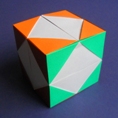 |
|
Name: The Twisted
Square Cube Modules / Paper
shape / Folding geometry: 6 modules from squares
using standard folding geometry.
Designer /
Date: David Mitchell, 1989. Subsequently, in
October 1990, Francis Ow sent me a copy of his
privately published book on Modular Origami which
also contains diagrams for this cube under the
title Cube 3. I do not know which of us has
priority.
Diagrams:
On-line diagrams are available on the Modular Designs page of this site.
|
|
| |
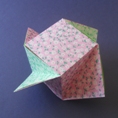 |
|
These Pinwheel Cubes,
were conceived of as a modular assembly
challenge. The basic cube has four wings, all
visible in the photo. The challenge is to take
the modules apart and then put them back together
with one, two, three and finally four of the
wings tucked away inside the cube. The design is
from 1999. Diagrams are not yet available.
|
|
| |
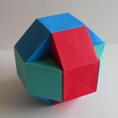 |
|
The 6-part
Rhombicuboctahedron can be made from
squares divided into either 3x3 or 4x4 grids. The
3x3 grid version was discovered by Kenneth
Kawamura in the early to mid 1970s. Robert E
Neale independently discovered the same design,
and quite possibly also the 4x4 version, but
cannot now recall at what date the discovery was
made. Michael Naughton and I both also discovered
both versions for ourselves in 1991 and 1988
respectively. Michael realised that the
proportions of the designs could be varied so
that the flat faces become oblongs rather than
squares. He calls this variable version the
Multi-Ball. The 4x4 version can be tweaked so
that it becomes an even distribution design. On-line diagrams are
available on the Modular Designs page of this site.
|
|
| |
 |
|
Gaia is one of the
designs that I discovered while playing with the
possibilities inherent in the Enigma base in
1989. Like my 6-part Enigma Cube it is a three
stage modular design in that the form continues
to develop after the modules have been assembled. Diagrams can be
found in Paper Crystals - David Mitchell - Water
Trade - ISBN 9780953477494.
|
|
| |
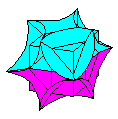 |
|
My 2-part Enigma Cube
is developed from the Enigma base, hence the
title of the design. This was the earliest
version of the Enigma form. In order to maintain
the integrity of the curved collars the design is
best realised using foil backed paper. Diagrams can be
found in Paper Crystals (2nd Edition) - Water
Trade - ISBN 978-0-9534774-9-4.
|
|
| |
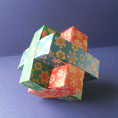 |
|
This is a 3x3 grid
version of my Omicron design
folded from 6 squares. Diagrams are not yet
available.
|
|
| |
| Designs from the 5x5
grid |
| |
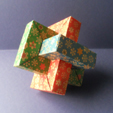 |
|
Borromean
Links - improved modular method for
Thoki Yenn's Umulius Rectangulum - 12 squares. |
|
Y054 |
|
1999 |
|
Diagrams not yet
available - photo only in Origami: The Complete
Guide to the Art of Paperfolding - Rick Beech -
Lorenz Books (Anness Publishing) - ISBN
0754807827 |
|
| |
| |











